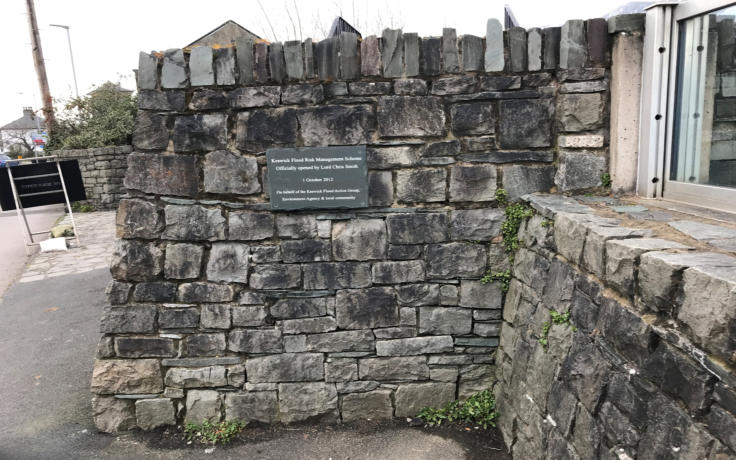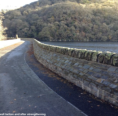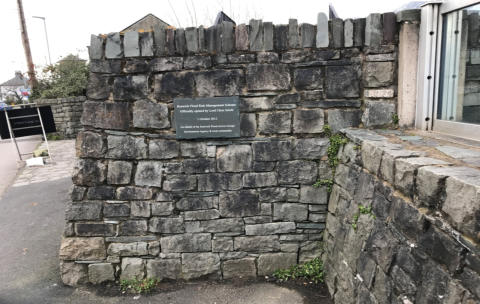
KESWICK FLOOD ACTION GROUP
ABOUT - 00
info@keswickfloodactiongroup.co.uk

Following
the
floods
of
2005,
very
early
on
conversations,
led
by
Lord
Campbell-Savours
(Keswick’s
MP
at
the
time),
began
with
UU
over
the
operation
of
Thirlmere
Reservoir
and
its
contribution
to
flood
flows
in
Keswick.
Improving
the
river
defences
was
an
early
priority
given
that
we
were
told
by
the
EA
that
replacing
Greta
Bridge
was
too
costly
to
be
considered
(it
still
is!).
There
were
almost
4
years of meetings/reports/studies/surveys and just when plans were coming together ….
Keswick
flooded
again
in
2009.
We
were
in
a
much
better
place
with
regard
to
flood
response
and,
from
here,
Keswick
Town
Council
have
continued
to
financially
support
an
emergency
response
Co-ordinatior.
There
is
a
system
to
turn
the
Council
Chambers
into
a
hub
for
any
emergency
and
Keswick
has
a
considerable
number
of
well-equipped
and
trained
responders
as
part
of
a
response
which
has
been
nationally
recognised
as
excellent.
The
2009
floods
led
to
further
analysis
of
the
flood
event
and
more
meetings/reports/studies/surveys. Frustratingly long delays. Finally the river defences were upgraded in 2012 costing >£6million
We
had
also
been
pushing
for
a
new
town
sewage
system,
especially
as
the
Elliott
Park
area
was
repeatedly
flooding
with
foul
water
excess
from
the
old
pump
station
and
the
aged
and
inadequate
drainage
for
surface
water.
UU
completed
the
new
sewage
system
in
2012
costing
~
£30million
to
reduce
foul
water
flooding.
It
consists
of
large
storage
chambers
on
the
Rawnsley
site
and
a
system
which
pumps
the
foul
water
over
Greta
Bridge
via
a
pipe
in
the
wider
parapet
wall
and
out
west
of
the
town
to
the
treatment
works.
It
was
only
designed
to
a
1:30
year
rainfall
event
as
that
was
all
that
was
required
of
UU.
Hardly
future-proofed
but
never-the-less
a
huge
improvement for those who had endured repeated flooding of the worst kind.
As
a
result
of
many
years
of
discussions
with
CCC
over
surface
water
problems
in
2015
KFAG
raised
£20K
for
a
mobile
community
pump
and
have
the
assurance
from
CCC
that
a
second
mobile
pump
is
permanently
available
in
Keswick
until
all
the
major
surface
water flood risks currently identified have been solved.
2015:
Storm
Desmond.
The
Floods
of
2015
were
a
huge
blow
for
us
all.
To
be
fair
the
river
defences
were
not
designed
to
cope
with
the
volume
of
rainfall
that
the
area
experienced
over
that
38
hour
period,
but
to
see
tree
debris
hanging
off
the
glass
panels
and
the
devastation
wrought
on
so
many
locals
once
again
was
hard
to
bear.
The
EA
tell
us
that
there
is
no
money
for
improvements
to
the
river
defences
and
some
locations
are
acknowledged
to
be
lower
than
others.
The
landslides
and
environmental
damage
to
the
area
around Low Briery remains a deep concern.
2016
After
many
years
of
meetings
and
campaigning
CCC
installed
new
underground
automatic
surface
water
pumps
in
Elliott
Park.
These can cope with surface water but
will never be a match for flooding when the river overtops the defences.
2019
The
EA
commissioned
a
report
from
the
British
Geological
Society
over
the
landslide
area
upstream
of
Keswick.
The
experts
tell
us that a serious rockfall that blocks the river during a period of high rainfall is a highly unlikely scenario. We continue to monitor the
2021
Construction
is
underway
to
put
a
pipe
to
the
river
from
Calvert
Way.
KFAG
wrote,
way
back
in
2014,
warning
of
the
surface
water
flood
risk
to
Brundholme
Gardens
area
and
expressing
concerns
about
this
being
exacerbated
by
the
proposed
development.
Sadly,
there
were
many
faults
with
the
drainage
plans
and
construction
of
the
housing
development
and
our
fears
were
realised.
After
5
years
of
mediation
meetings
between
KFAG,
the
builders,
planners
and
CCC,
this
solution
is
now
almost
complete.
Throughout
the
whole
of
KFAG’s
existence
we
have
campaigned
for
(and
largely
succeeded
in
getting)
known
problem
culverts
etc.
reconfigured
and
maintained
to
reduce
surface
water
risk.
Routine
gravel
removal
is
undertaken
by
the
EA
in
the
High
Hill
area
and
KFAG
has
submitted
many
reports
to
Government,
been
involved
in
numerous
national
policy
debates
and
has
been
represented
on
two
select
committees.
We
have
worked
with
flood
groups
in
our
catchment,
county-wide
and
nationally.
So
…
the
projects
ongoing
at
this
moment
in
time:
a
sub
group
are
considering
proposals
for
the
bund
behind
the
Friends
Meeting
House
following
suggestions
that
it
should
be
lowered
to
prevent
deep
ponding
in
the
area.
Locals
are
adamant
that
lowering
the
bund
would
allow
drainage
into
the
rugby
field,
prevent
depth
and spread of ponding which might reduce flood risk for Booths, properties on The Headlands/businesses nearby.
Whilst
we
know
that
tree
planting
and
the
improvement
of
wetlands
on
the
fells
is
a
good
thing,
we
believe
that
these
measures
are
When
KFAG
first
formed
in
2005
we
seemed
to
be
mostly
focussed
on
protection
from
the
River
Greta.
Over
the
years
our
understanding
of
our
community’s
flood
risks
have
grown.
Although
there
was,
and
still
is,
a
lot
to
do
it
is
worth
saying
that,
working
with
(in
particular)
the
Environment
Agency
(EA),
Cumbria
County
Council
(CCC)
and
the
local
water
company
United
Utilities
(UU)
–
and
with
the
unfailing
and
exceptional
support
we
have
received
from
Keswick
Town
Council
and
the
local
community
-
so
much
more
has
been
achieved
than
we had ever first considered:


2
017
UU
reinforced
their
reservoir
wave
wall
beside
the
road
across
the
dam
following
video
evidence
KFAG
took
over
the
state
of
the
roadside
wall.
UU
have
now
reinforced
the
wall.
We
know
that
there
have
been
some
complaints
that
the
road
seems
no
longer
wide
enough
for
two
lanes
of
traffic
BUT
this,
we
would
suggest,
is
a
better
outcome
than
relying
on
a
wall
only
43cms
wide
to
hold
back
so
much
water.
During
Storm
Desmond
the
reservoir
level
rose
over
a
metre
up
the
“wave
wall”.
KFAG
insisted
that
it
was
not
safe
or
robust
enough
to
be
considered
a
reservoir
retaining
structure.
There
were
holes
under
some
capping
stones,
the
wall
needed
repointing,
vegetation
was
growing
in
cracks
and
it
clearly
was
not
wide
enough
or
strong
enough.
Frankly
we
believe
we
were
lucky
that
it
held
through
the
winter
storms
of
2015/16.
The
consequences
of
failure
of
a
section
of the road wall during an event similar to Storm Desmond do not bear thinking of.
PHOTO: Reinforced wave wall at Thirlmere Dam
KESWICK FLOOD ACTION GROUP

ABOUT-00

When
KFAG
first
formed
in
2005
we
seemed
to
be
mostly
focussed
on
protection
from
the
River
Greta.
Over
the
years
our
understanding
of
our
community’s
flood
risks
have
grown.
Although
there
was,
and
still
is,
a
lot
to
do
it
is
worth
saying
that,
working
with
(in
particular)
the
Environment
Agency
(EA),
Cumbria
County
Council
(CCC)
and
the
local
water
company
United
Utilities
(UU)
–
and
with
the
unfailing
and
exceptional
support
we
have
received
from
Keswick
Town
Council
and
the
local
community
-
so
much
more has been achieved than we had ever first considered:
Following
the
floods
of
2005,
very
early
on
conversations,
led
by
Lord
Campbell-Savours
(Keswick’s
MP
at
the
time),
began
with
UU
over
the
operation
of
Thirlmere
Reservoir
and
its
contribution
to
flood
flows
in
Keswick.
Improving
the
river
defences
was
an
early
priority
given
that
we
were
told
by
the
EA
that
replacing
Greta
Bridge
was
too
costly
to
be
considered
(it
still
is!).
There
were
almost
4
years
of
meetings/reports/studies/surveys
and
just
when
plans
were
coming
together
….
Keswick
flooded
again
in
2009.
We
were
in
a
much
better
place
with
regard
to
flood
response
and,
from
here,
Keswick
Town
Council
have
continued
to
financially
support
an
emergency
response
Co-ordinatior.
There
is
a
system
to
turn
the
Council
Chambers
into
a
hub
for
any
emergency
and
Keswick
has
a
considerable
number
of
well-equipped
and
trained
responders
as
part
of
a
response
which
has
been
nationally
recognised
as
excellent.
The
2009
floods
led
to
further
analysis
of
the
flood
event
and
more
meetings/reports/studies/surveys.
Frustratingly
long
delays.
Finally
the
river
defences were upgraded in 2012 costing >£6million
We
had
also
been
pushing
for
a
new
town
sewage
system,
especially
as
the
Elliott
Park
area
was
repeatedly
flooding
with
foul
water
excess
from
the
old
pump
station
and
the
aged
and
inadequate
drainage
for
surface
water.
UU
completed
the
new
sewage
system
in
2012
costing
~
£30million
to
reduce
foul
water
flooding.
It
consists
of
large
storage
chambers
on
the
Rawnsley
site
and
a
system
which
pumps
the
foul
water
over
Greta
Bridge
via
a
pipe
in
the
wider
parapet
wall
and
out
west
of
the
town
to
the
treatment
works.
It
was
only
designed
to
a
1:30
year
rainfall
event
as
that
was
all
that
was
required
of
UU.
Hardly
future-proofed
but
never-the-less
a
huge
improvement for those who had endured repeated flooding of the worst kind.
As
a
result
of
many
years
of
discussions
with
CCC
over
surface
water
problems
in
2015
KFAG
raised
£20K
for
a
mobile
community
pump
and
have
the
assurance
from
CCC
that
a
second
mobile
pump
is
permanently
available
in
Keswick
until
all
the
major
surface
water
flood
risks
currently
identified have been solved.
2015:
Storm
Desmond.
The
Floods
of
2015
were
a
huge
blow
for
us
all.
To
be
fair
the
river
defences
were
not
designed
to
cope
with
the
volume
of
rainfall
that
the
area
experienced
over
that
38
hour
period,
but
to
see
tree
debris
hanging
off
the
glass
panels
and
the
devastation
wrought
on
so
many
locals
once
again
was
hard
to
bear.
The
EA
tell
us
that
there
is
no
money
for
improvements
to
the
river
defences
and
some
locations
are
acknowledged
to
be
lower
than
others.
The
landslides
and
environmental
damage
to
the
area
around Low Briery remains a deep concern.
2016
After
many
years
of
meetings
and
campaigning
CCC
installed
new
underground
automatic
surface
water
pumps
in
Elliott
Park.
These
can
cope
with
surface
water
but
will
never
be
a
match
for
flooding
when
the
river
overtops the defences.
2017
UU
reinforced
their
reservoir
wave
wall
beside
the
road
across
the
dam
following
video
evidence
KFAG
took
over
the
state
of
the
roadside
wall.
UU
have
now
reinforced
the
wall.
We
know
that
there
have
been
some
complaints
that
the
road
seems
no
longer
wide
enough
for
two
lanes
of
traffic
BUT
this,
we
would
suggest,
is
a
better
outcome
than
relying
on
a
wall
only
43cms
wide
to
hold
back
so
much
water.
During
Storm
Desmond
the
reservoir
level
rose
over
a
metre
up
the
“wave
wall”.
KFAG
insisted
that
it
was
not
safe
or
robust
enough
to
be
considered
a
reservoir
retaining
structure.
There
were
holes
under
some
capping
stones,
the
wall
needed
repointing,
vegetation
was
growing
in
cracks
and
it
clearly
was
not
wide
enough
or
strong
enough.
Frankly
we
believe
we
were
lucky
that
it
held
through
the
winter
storms
of
2015/16.
The
consequences
of
failure
of
a
section
of
the
road
wall
during
an
event
similar
to
Storm
Desmond
do
not
bear thinking of.
2019
The
EA
commissioned
a
report
from
the
British
Geological
Society
over
the
landslide
area
upstream
of
Keswick.
The
experts
tell
us
that
a
serious
rockfall
that
blocks
the
river
during
a
period
of
high
rainfall
is
a
highly
unlikely
scenario.
We
continue
to
monitor
the
area
and
the
deterioration
of
the
old
road to Threlkeld which has been closed to traffic since 2009 floods.
2020
The
Penrith
Road
Scheme.
It
was
recognised
that
surface
water
would
be
trapped
behind
the
river
defences.
When
the
defences
were
to
be
constructed
back
in
2012,
we
were
told
that,
if
we
asked
for
this
to
be
included
in
the
scheme
then
it
would
be
prohibitively
expensive,
basically
Keswick
would
get
nothing.
So,
after
8
more
years,
CCC
finally
completed
a
scheme
to
provide
some
upstream
storage
in
a
pond
by
Springs
Road,
improvements
to
drainage
pipes
across
the
Victorian
part
of
town
to
the
river
and
an
underground
pump
station
on
Penrith
Road
to
force
the
surface
water
into
the
river
when
the
Greta
is
high.
As
a
plus,
adjoining
the
electrical
housing
for
these
pumps,
Keswick
got
a
nice
new
bus
shelter
with
a
painting
of Goldilocks and the three bears!
2021
Construction
is
underway
to
put
a
pipe
to
the
river
from
Calvert
Way.
KFAG
wrote,
way
back
in
2014,
warning
of
the
surface
water
flood
risk
to
Brundholme
Gardens
area
and
expressing
concerns
about
this
being
exacerbated
by
the
proposed
development.
Sadly,
there
were
many
faults
with
the
drainage
plans
and
construction
of
the
housing
development
and
our
fears
were
realised.
After
5
years
of
mediation
meetings
between
KFAG,
the
builders,
planners
and
CCC,
this
solution
is
now
almost
complete.
Throughout
the
whole
of
KFAG’s
existence
we
have
campaigned
for
(and
largely
succeeded
in
getting)
known
problem
culverts
etc.
reconfigured
and
maintained
to
reduce
surface
water
risk.
Routine
gravel
removal
is
undertaken
by
the
EA
in
the
High
Hill
area
and
KFAG
has
submitted
many
reports
to
Government,
been
involved
in
numerous
national
policy
debates
and
has
been
represented
on
two
select
committees.
We
have
worked
with
flood
groups
in
our
catchment,
county-wide
and
nationally.
So
…
the
projects
ongoing
at
this
moment
in
time:
a
sub
group
are
considering
proposals
for
the
bund
behind
the
Friends
Meeting
House
following
suggestions
that
it
should
be
lowered
to
prevent
deep
ponding
in
the
area.
Locals
are
adamant
that
lowering
the
bund
would
allow
drainage
into
the
rugby
field,
prevent
depth
and
spread
of
ponding
which
might
reduce
flood
risk
for
Booths,
properties on The Headlands/businesses nearby.
Whilst
we
know
that
tree
planting
and
the
improvement
of
wetlands
on
the
fells
is
a
good
thing,
we
believe
that
these
measures
are
largely
insignificant
to
Keswick’s
flood
risk.
Wetland
improvements
are
trumpeted
with
X
cubic
metre
capacity
without
an
honest
explanation
that
such
volumes
only
represent
a
few
seconds
of
the
flows
down
the
Greta
during
Desmond.
Trees
can
hold
water
and
transpiration
also
has
benefits
but
in
the
winter
months
growth
is
slowed
and
the
number
of
trees
lost
in
the
catchment
is
not
offered
up
as
a
balance
to
the
new
ones
planted
(which
will
take
many
years
to
make
anything
like
a
difference
in
comparison
with
the
forests
loss
through
commercial
logging/ash
dieback
and
so
on).
Some
honesty
is
needed
into
the
scale
of
the
problem
the
effectiveness
of
NFM
measures
in
the
light
of
that
scale
AND
whether
the
saplings
littering
the
fellsides
in
their
green
plastic
sheaths
will
compensate
for
the
daily
loss
of
mature
trees
in
the
catchment.
We
believe
in
a
full
catchment
approach
but,
realistically,
the
area
is
so
large,
the
rainfall
so
intense
and
prolonged
in
winter
storms
that
the
only
real
solution
to
long-term
flood
risk
reduction
is
significant
upstream
storage.
“Slowing
the
flow”
is
not
the
whole
story.
“Managing
peak
flows”
is,
in
KFAG’s
view,
the
best
way
to
reduce
flood
risk.
Greta
Bridge
is
a
throttle,
indeed
all
the
bridges
in
Keswick
are,
and
so
we
need
to
get
the
water
efficiently
through
these
constrictions
as
the
flows
will
slow
when
the
water
spreads
across
the
Howrah’s
and
on
into
Bassenthwaite.
Thus
the
risk
is
not
passed
on
downstream
to
communities
in
the
west.
Similarly,
it
does
not
make
sense
to
slow
all
tributaries
down,
holding
as
much
water
in
the
upper
catchment
to
reduce
all
the
tributaries
of
the
Greta
peaking
at
the
same
time
reduces
the
strain
on
the
river
defences.
KFAG,
the
community,
do
not
want
to live behind higher walls.
Thirlmere
could
and
should
provide
a
solution.
We
are
still
calling
for
legislation
to
manage
the
reservoir
for
flood
prevention.
Dr
Ed
Henderson
and
Al
Cook
gave
a
good
deal
of
their
time
and
expertise
to
produce
a
Water
Balance
Model
for
Thirlmere
which
used
the
data
from
Storm
Desmond
and
showed
that,
had
there
been
the
sort
of
management
regime
for
which
KFAG
has
campaigned
over
many
years,
Keswick
would
not
have
flooded
from
the
river
even
in
Storm
Desmond.
Frankly
we
are
no
further
forward
than
early
2010
from
when
we
had
negotiated
trigger
levels
to
try
to
create
storm
space
in
the
reservoir.
The
lack
of
success
in
no
way
reflects
the
time
and
effort
that
KFAG
have
put
in
to
make
our
community
safer.
In
2020
KFAG
produced
a
memorandum
which
uses
Ed
and
Al’s
work
to
set
out
what
is
needed
to
better
protect
the
community.
It
had
the
full
support
of
both
Keswick
Town
and Allerdale Borough Councils.
ABOUT - 00
ABOUT





































